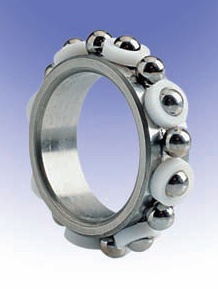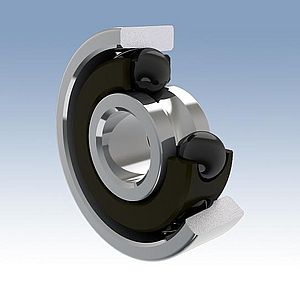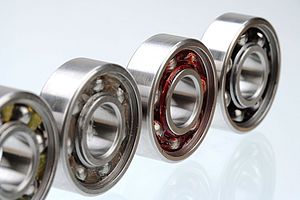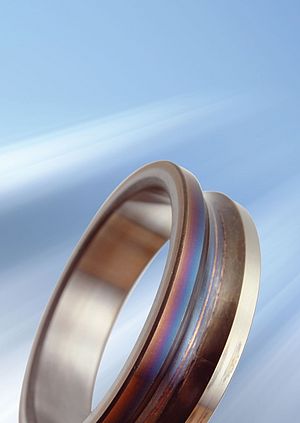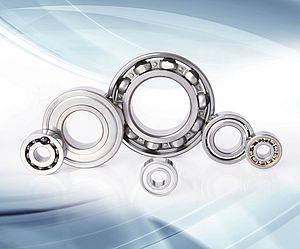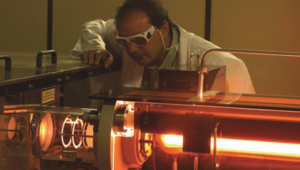Optical systems are now employed widely across many industry sectors, notably in defense applications, but also in commercial use. Super precision ball bearings are critical in ensuring that these systems remain stable and reliable under harsh operating conditions.
In military applications, the latest advanced infrared seeker systems require super precision ball bearings, which are designed to support the intricate mirror and lens arrangements contained within such optical systems.
Rather than utilising standard catalogue bearings for these types of applications, optical guidance systems demand the use of bespoke precision bearings, especially if the application is critical in nature or if it requires a bearing solution that offers specific technical advantages such as long life, high reliability, high stiffness and low torque levels.
In order to allow the seekers to look through a broad field of vision, the optical elements are typically mounted in a gimbal system. These systems usually consist of two axes, elevation and azimuth, which operate independently. To ensure that the optics are perfectly aligned, it is necessary to fix one end of each of these axes, typically this is performed by using a duplex pair of bearings that are clamped to both the shaft and housing. At the free end of the shaft either a similar duplex pair of bearings can be used, clamped only to the shaft, or a spring preload can be applied to a single bearing. In both cases, clearance to the housing is critical and the bearings must be free to float axially under the effects of thermal expansion.
The requirements on the bearings are very demanding. Factors such as the stiffness of the bearings, the friction torque levels, the bearing precision, lubrication methods and materials need careful consideration. There is always a trade-off between the stiffness and the torque levels required of the bearings. Typically, these optical systems have tight constraints on the size and mass of the installation and as such there are restrictions on the amount of power available to the motors driving the optical system. The internal configuration of the bearings for high stiffness and low torque has conflicting requirements and as such the design must be optimised to meet both parameters.
Stiffness, for example, is important when it comes to controlling the precise position of optical elements. In an angular contact or deep groove ball bearing, the number of balls, the size of the balls and the curvature of the inner and outer ring and the level of preload can be altered in order to optimise the overall stiffness of the bearings.
In optical guidance systems used in military weapons systems, typically ball bearings are used that provide high stiffness in order to counteract the high G forces and vibration levels involved. The latest infrared seeker systems for example perform under high maneuvering loads and in harsh environments with respect to vibration. The bearings must hold the optical components in position at all times, often to an accuracy of a few microns. The bearings are therefore absolutely critical to the performance of the overall guidance system.
In bearing design, lubrication is another key consideration. For optical guidance applications, wet lubrication is not normally an option when the system utilises lenses and other optical components. If vapours from the oil or grease condense onto the surface of a mirror, for example, the performance of the guidance system could be compromised. Most ball bearings for such systems therefore use a dry lubricant so that no oil or grease is present in the system.
For most optical guidance applications, Barden provides bearings in 440C. This is a martensitic stainless steel that provides good corrosion resistance. To reduce friction and to reduce adhesive wear, the bearings can also be designed with retainers that incorporate PTFE as a source of lubrication, particularly for applications in which oscillatory movement of the bearings is required.
Often the bearings are designed with special ball separators (toroids) positioned over every other ball in the bearing and manufactured from a self-lubricating material. This ensures the bearing meets the low torque requirements of the application. The toroids also enable a high complement of balls to be assembled within the bearing, which helps to increase the load carrying capability and stiffness of the bearings.
This self-lubricating material is typically virgin PTFE, however other alternative materials have been developed which comprise of a blend of molybdenum disulphide and glass fibre. For dry lubricated bearing systems, coatings are available for the raceways and balls. These include MoS2, MoST and silver coatings.
Clearances with mating components must normally be kept to a minimum, as any percussive loads generated by vibration will affect the optical system’s performance. To attain these, Barden often supplies kits of parts to the customer, pre-matched to controlled clearances in order to simplify and minimise assembly time and costs. Bearings manufactured to ABEC7 precision standards provide runouts in the micron range.
Super precision custom engineered ball bearings are also required in commercial optical guidance applications, including stabilised camera or video systems and associated mechanical gimbals and gyros. Here, the bearings themselves may not be directly linked to the camera’s optical system, but are nonetheless still critical in ensuring that the camera system is sufficiently stable during filming.
Vehicle or helicopter-mounted cameras and digital video platforms require high performance stabilisation systems in order to compensate for any erratic movements of the vehicle, providing a stable, steady platform for filming to take place. The Police, Armed Forces and rescue workers often require these types of systems during their operations.
Barden provides bearing solutions for a range of mechanical gimbal systems and gyros for such stabilised camera platforms. Here, a gyro bearing spin axis system may utilise a cartridge bearing unit, which incorporates a bearing with two rows of balls, a single outer ring and two inner rings. The advantage of this design is that the customer can mount the bearings quickly and easily into their own assembly. Normally, the customer simply mounts on the outer ring by clamping the two inner rings together.
“By manufacturing a bearing to have a precise gap between the two inner rings, a specific preload can be consistently attained when the bearing is mounted in the gyro,” explains Eley. These gyroscopes will typically be mounted in a gimbal arrangement similar to the optical systems described above. In these situations, it is common for the bearings to be lubricated using the Barden PA cage. These cages are stainless steel ribbon cages that are coated on the inside surfaces with PTFE to provide low friction under small oscillatory movements.


